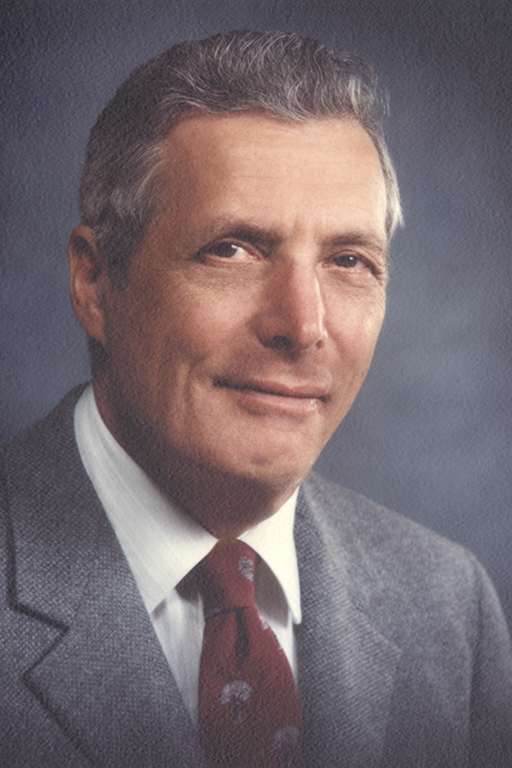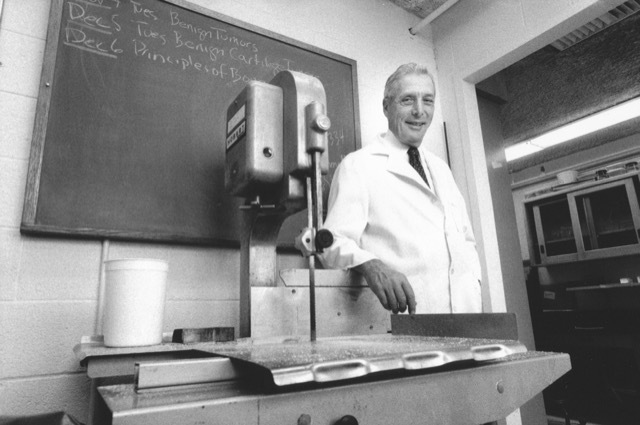The entire team at UBMD Orthopaedics & Sports Medicine mourns the loss of Dr. Eugene R. Mindell, first chair of the Department of Orthopaedics at the University at Buffalo and professor emeritus at the Jacobs School of Medicine & Biomedical Sciences, who passed away Friday, Feb. 15, 2019 at the age of 96.
A leader in orthopaedic medicine, Dr. Mindell came to Buffalo in 1953 from his home in Chicago, opening a private practice in Western New York. Less than a decade later, he was asked to become the first full-time professor and chair of the university’s Division of Orthopaedic Surgery in 1964, going on to lead the department for nearly a quarter of a century and helping to forge the way ahead for the modern study and practice of orthopaedic medicine. Under his tenure, the university recruited a number of full-time faculty members, fostered a culture of research, and focused on the training of medical residents.
Dr. Mindell was raised in Chicago and began his career there, graduating with his medical degree from the University of Chicago in 1945 before joining the U.S. Navy to serve with the Veterans Administration from 1945-46. Following his discharge, he returned to Chicago for his residency and began his lifetime of work focusing on the diagnosis and treatment of bone cancer, working alongside leading researchers at the University of Chicago. His drive to improve treatments and reduce mortality rates led to the opening of the Orthopaedic Bone Pathology Laboratory, developed and opened at UB under his tenure as chair in 1967, expanding the opportunities for researchers and medical students to better understand the structures of bone tumors and orthopaedic oncology.
Dr. Mindell remained active in medicine even after his retirement as chair in 1988, and continued to be an active leading researcher in orthopaedic oncology. In fact, he was published as the lead researcher on more than 100 scientific papers throughout his career and saw the survival rate for osteosarcomas improve from 20 percent to around 70 percent during his lifetime. He saw and participated in the development of new approaches that helped reduce limb loss from bone cancers and saw mortality rates for cancer patients improve through the use of new sciences and technologies such as chemotherapy, which started as a new procedure in the 1970s and has become an integral part of many treatments still today.
 He also worked as a leader to guide young doctors in their study of orthopaedic medicine well into his retirement, continuing to work to improve students’ knowledge of orthopaedics and the educational standing of the university as a whole. He was also well respected in the field and a member of many professional organizations. He was a founding member of the Musculoskeletal Tumor Society, former president of the American Board of Orthopaedic Surgery, a board member of the American Academy of Orthopaedic Surgeons, chairman of the AAOS’ Council of Musculoskeletal Specialty Societies, and member of the Orthopaedic Research Society. He also served as an associate editor and board member at the Journal of Bone and Joint Surgery and was the former deputy editor of the Journal of Clinical Orthopaedics and Related Research.
He also worked as a leader to guide young doctors in their study of orthopaedic medicine well into his retirement, continuing to work to improve students’ knowledge of orthopaedics and the educational standing of the university as a whole. He was also well respected in the field and a member of many professional organizations. He was a founding member of the Musculoskeletal Tumor Society, former president of the American Board of Orthopaedic Surgery, a board member of the American Academy of Orthopaedic Surgeons, chairman of the AAOS’ Council of Musculoskeletal Specialty Societies, and member of the Orthopaedic Research Society. He also served as an associate editor and board member at the Journal of Bone and Joint Surgery and was the former deputy editor of the Journal of Clinical Orthopaedics and Related Research.
Dr. Mindell was also honored with several accolades for his continued work in advancing orthopaedic medicine. In 1986, he received the Dean’s Award from UB’s Medical School, and was honored with the Distinguished Service Award from his alma mater, the University of Chicago, in 1990. He also received the Achievement in Health Care Award from D’Youville and the Lifetime Achievement Award from UBMD Orthopaedics & Sports Medicine, both in 2002. In recent years, Dr. Mindell was honored by the Medical Society of the County of Erie with its Distinguished Service Award in 2012, recognizing his extensive career in advancing medical science and technology.
A giant in the field of orthopaedics, Dr. Mindell’s contributions to medicine – not only here in Buffalo, but for physicians, hospitals and patients around the world – cannot be overstated. Our faculty, our students and our patients have truly suffered a loss and we can only hope to continue to advance medical study and practice in his same spirit.
We asked some of the physicians who worked with Dr. Mindell throughout the years to share their thoughts and we have included their memories below.
When I started my career at ECMC, there were five giants on the medical staff who left their imprint in the history of medicine in Buffalo. These included George Alker, MD (neuroradiology), John Border, MD (trauma surgery), Franz Glasauer, MD (neurosurgery), Glen Gresham, MD (rehabilitation medicine), and, of course, Eugene Mindell, MD. I was fortunate to work with all of these outstanding physicians.
Dr. Mindell always stood out in the crowd. Our offices were right next to each other when I first started in practice, so we interacted on a daily basis. He would stop on most days to see how I was doing and offer his help to understand the workings of the hospital and in particular the trauma program – and he was very kind to me. He went out of his way to introduce me to other members of the orthopedic department and within ECMC. These were the glory days that the spinal cord injury and brain injury programs were being developed at ECMC. We had weekly joint conferences with all of the main disciplines, and Dr. Mindell’s input was always sought after. During this time, he served as the orthopedic spine surgeon for the spinal cord injury unit.
I have many examples of the fine person and physician Dr. Mindell was. One day I was doing an EMG on a rather belligerent patient, and Dr. Mindell came barreling in the room to make sure I was OK. On another incident, we had a young spinal cord injured patient on the unit that died of a pulmonary embolism. It was devastating to all of us. Dr. Mindell made it his mission to make sure that we did everything we could in the future to prevent this. On his insistence we brought back what we all thought was ancient technology – intermittent pneumatic compression. None of us thought this would be effective. We were one of the first hospitals to use the technology. Of course, the rest is history – our incidence of DVT and pulmonary embolism dropped dramatically, precisely as Dr. Mindell had thought. Ultimately the use of intermittent pneumatic compression became the gold standard used by hospitals all over the world.
I recall being asked to give grand rounds to the orthopedic department, and always seeing Dr. Mindell, even in his later years sitting in the front row. He always made sure to come up and say hello and ask me how I was doing. He continued this over the years, when he was at Canterbury Woods. I have a few emeritus faculty as patients and they would always bring greetings from Dr. Mindell.
Dr. Mindell is the last of the giants to pass away, but my memories of his expertise and kindness will always stay with me.
– James J. Czyrny, MD
Dr. Eugene Mindell was a world-class husband, father, grandfather, great-grandfather, friend, physician, scientist, teacher and mentor. He approached everything with great purpose and enthusiasm.
I met Dr. Mindell in the twilight of his career, 34 years ago, in the last few years of his 24 years as the first chairman of the combined University Orthopedic program and after he was the president of the American Board of Orthopedic Surgeons and a founding member and president of the Musculoskeletal Tumor Society. He was 62 years old and getting ready to start the next phase of his career, not retirement.
The next phase would include recruiting great physician-scientist teachers to the orthopaedic department and assisting the next three chairmen in mentoring junior faculty and educating 30 more years of orthopaedic surgeons. He would drive himself, in his Volvo, to the hospital each day to teach in the clinic and under the microscope until he couldn’t drive anymore. Then, he switched to a cab for transportation and cut back to three days a week.
Dr. Mindell was a storyteller that had many more stories to tell and create. Storytelling was one of his gifts that he would use to teach all that would listen. Of course, he had a penchant to retell his favorite stories, but he’d say ‘If you have heard this one before wave your hand and if you had heard it twice, use both.’ His beloved wife, June, and his children told me long ago that on occasion they would take off their shoes too, so they’d wave both hands and feet above the dinner table to stop him from retelling some stories. I will very much miss Dr. Mindell, his wisdom and his stories.
– Brian E. McGrath, MD

